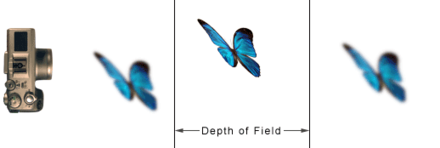
Three Ways to Control Depth of Field
I’d highly recommend checking it out. Brian did a nice job of explaining the three things that affect depth of field (aperture, camera to subject distance, and focal length), including some sample images too.
There’s a few things I’d like to add though:
If the f-number is doubled, then the depth of field is also doubled. Note that “doubling” here literally means doubling (e.g. from f/4 to f/8), it does NOT mean one whole stop (e.g. from f/4 to f/5.6).
If the subject distance is doubled, then the depth of field is increased by four times (depth of field is proportional to the subject distance squared).
If the focal length is doubled, then the depth of field is decreased by four times (depth of field is inversely proportional to the focal length squared).
So, if you’re looking for small depth of field (i.e. to help isolate your subject against an out-of-focus background), then the key is to use a small f-number, get close, and use a long focal length lens.
The only place I’ve seen these three things explained so precisely like this, is in Ansel Adams’ wonderful book, The Camera. It’s 195 pages of pure magical goodness, and it’s a book that I constantly reread and go back to. I just wish there was a pocket size edition too
Get more nature photography tips in our free weekly newsletter
 About the Author: Steve Berardi is a nature photographer, software engineer, and founder of PhotoNaturalist. You can usually find him hiking in the beautiful mountains and deserts of Southern California.
About the Author: Steve Berardi is a nature photographer, software engineer, and founder of PhotoNaturalist. You can usually find him hiking in the beautiful mountains and deserts of Southern California.

.4 Sensor size?
hi,
As the post you refer to puts it, “All this technical stuff is fine and dandy, but how does it translate to real world photography? ”
Lets take a real-world example such as an outdoor portrait. Supposing I have a constant aperture f2.8, 50-200mm zoom set to a given f-number, I would obtain the same subject-composition at 10 feet with lens at 50mm than at 40 feet with lens at 200mm ( _correct me and read no further if I am wrong here_ ), and according to the DoF calculator, roughly the same DoF.
I don’t know if this is exact or approximate (the maths seem a bit complicated), and I have not tried it out (I don’t own such a zoom). Other elements should not be overlooked too : background composition would of course be very different, and the bokeh (the blurry effect) might have a different quality at 50mm than at 200mm.
So if this is correct, for a chosen composition, the only factor to consider regarding DoF is the lens’ aperture. (Winston : yes DoF is also dependent on sensor size, but that is not a factor we can usually control)
-JChris